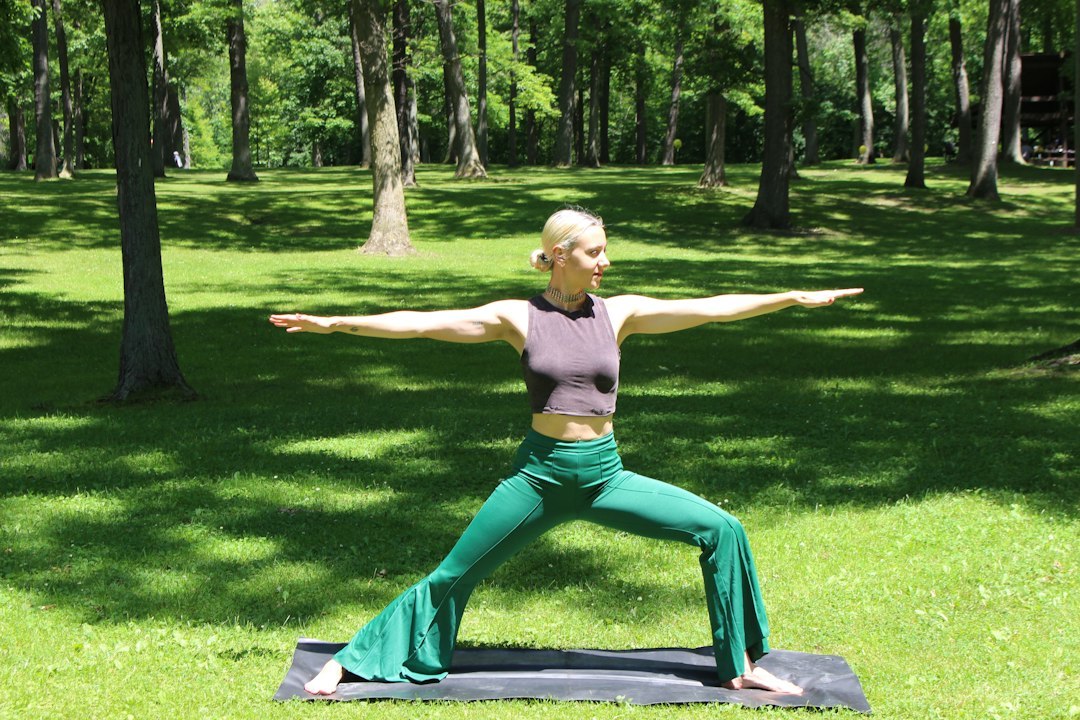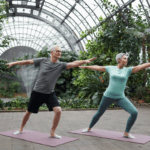Coming Soon: E-book about Kundalini Yoga - Sign up here to be among the first to get it!
Ever found yourself standing tall, feeling like you could take on the world? That’s the power of a **warrior pose**. Think about it—how often do we truly plant our feet and reach for the sky with fierce determination? This is not just some fancy stretch; it’s your inner strength manifesting through every muscle in your body. Picture this: You’re a warrior stepping onto an ancient battlefield. Your heart races but your breath is calm, arms reaching as if to embrace victory itself. Now imagine harnessing that same energy on your yoga mat—the sweat, the burn, all fueling a fire within. Are you curious yet? How can something as simple as a stance turn into such an empowering experience? Stay tuned because by diving deeper into these yoga poses with us today, you’ll learn how to build physical might and mental fortitude while unlocking secrets from history itself. Let me tell ya’, there’s more to this than meets the eye—and I’m here to walk you through each electrifying detail! Ready for action? Keep reading…
Table Of Contents:
- Warrior Pose Fundamentals – Understanding the Pose Basics
- Step-by-Step Guide to Perfecting Warrior Pose
- The Physical and Mental Rewards of Practicing Warrior Poses
- Anatomical Insights into Warrior Poses
- The Historical Tapestry Behind the Power of Virabhadrasana
- Mindful Movement – Avoiding Common Mistakes in Warrior Poses
- Scaled Variations of Virabhadrasana Tailored for Individual Needs
- Educational Cues from Yoga Teachers – Enhancing Practice Through Guidance
- FAQs about Warrior Pose
- Conclusion
Warrior Pose Fundamentals – Understanding the Pose Basics
Warrior poses are a dynamic group of asanas that create the cornerstone of hatha yoga‘s standing positions. They not only build strength and endurance but also invite mental clarity into your practice.
Defining Virabhadrasana – The Essence of the Warrior Pose
The warrior pose, or Virabhadrasana in Sanskrit, draws its name from a fierce warrior—an incarnation of Lord Shiva. In each variation, this powerful yoga posture embodies strength and focus. When you step into any warrior pose, it’s like embracing an inner battle; one where you conquer self-doubt and emerge more resilient.
A balanced sequence often includes these yoga poses because they provide an opportunity to ground through your feet while reaching upward with fervor—akin to a tree rooted deeply yet swaying gracefully with the wind.
Standing Strong – The Primary Warriors Unveiled
The five primary warrior poses are Virabhadrasana I, II, and III, Baddha Virabhadrasana, and Viparita Virabhadrasana. Each has distinct features: for instance, in Warrior I, your arms reach skyward which can help stretch those intercostal muscles tight from prolonged sitting; whereas Krishnamacharya’s teachings highlight how Humble Warrior challenges balance by inviting us to bow forward with grace.
In contrast, reversing into Viparita Virabadhrasna opens up our heart space—a gentle reminder that power comes paired with vulnerability. And let’s not forget about expanding side-to-side in Warrier II; it strengthens legs while stretching hip flexors making it perfect after hours at a desk job.
Step-by-Step Guide to Perfecting Warrior Pose
Entering Virabhadrasana I – Your Path to Strength and Stability
The journey into Warrior I, or Virabhadrasana I, begins with the feet planted firmly in mountain pose. As you step one foot back about 4 to 5 feet apart, make sure your front knee is bent at a 90-degree angle that aligns it directly over the ankle. This foundational stance sets you up for stability as both hip points face forward like headlights.
Raising your arms parallel overhead can feel empowering as they reach towards the sky while shoulder blades glide down your back. Engage your thigh muscles by imagining lifting them upward from the kneecaps – this helps build strength in both legs with an emphasis on keeping that front thigh parallel to the ground.
Your upper body should remain lifted and proud; however, be mindful not to let tension creep into your neck or shoulders. Instead of locking out joints, aim for a sense of buoyancy even as you root through each corner of both feet—this balance between grounding and reaching up embodies the warrior’s dual nature: humble yet powerful.
This yoga pose stretches the chest, lungs, shoulders, neck, belly and groin (psoas).
Teacher tips:
- Ensure students’ front knees do not extend past their ankles.
- Suggest using blocks under hands for those struggling with balance or flexibility.
Pose Variation/Beginner Tips:
Embracing Virabhadrasana II – Expanding Your Yoga Horizons
Moving gracefully from Warrior I into Virabhadrasana II, adjust so that hips open sideways now while maintaining a wide stance with arms stretched out strong but relaxed—palms facing down—to either side. Here in Warrior II, gaze past fingers of your front hand ensuring mental focus sharpens along with physical alignment where left heel intersects right foot arch at just the right spot—a testament to precision meeting power within this yoga horizon expansion.
The goal here is sustaining calm breaths even when thighs signal their workout during prolonged holding periods which builds endurance alongside concentration all whilst eyes stay steady looking beyond mere sight towards inner vision goals too.
It stimulates abdominal organs besides stretching legs and ankles.
Teacher tips:
- Instruct students to keep their gaze on their front fingertips.
Pose Variation/Beginner Tips:
Soaring into Virabhadrasana III – Cultivating Balance and Concentration
To launch yourself confidently into Warrior III (Virabhadrasana III), begin by shifting weight onto one leg before slowly leaning forward bringing the torso parallel over the standing leg and extending the other behind until the body forms T shape horizontal plane supported only on a single pillar-leg below without sacrificing integrity above thanks core engagement & straight line stretching fingertip-to-toe tip across imagined axis balancing act indeed.
This particular variation challenges our ability not just physically but mentally, demanding a blend of focus and resilience.
It strengthens ankles and legs, shoulders, and muscles of the back while toning the abdomen.
Teacher tips:
- Offer props like a wall or chair for balance support to beginners.
Pose Variation/Beginner Tips:
Warrior I lays the groundwork for strength and stability, so plant your feet and align your knee over the ankle. Reach high with strong arms but keep shoulders relaxed.
In Warrior II, open up to new angles—your hips turn sideways while you gaze forward, combining precision with power as you breathe through the intensity.
For Warrior III’s balance challenge, tip into a T shape on one leg. Stay focused; it’s not just physical—it tests mental resilience too.
The Physical and Mental Rewards of Practicing Warrior Poses
Striking a warrior pose does more than just look impressive; it’s like unleashing an ancient power that tones your body and sharpens your mind. When you step into any variation—be it Warrior I, II, or the poised balance of Warrior III—you’re not only channeling the mythical fighter Virabhadra but also reaping tangible benefits.
Building Strength with Every Stance
Muscles awaken as you hold a warrior pose. Your legs work hard to maintain stability, especially when one thigh parallels the ground while your arms reach energetically towards opposite horizons in Warrior II. This isn’t just about looking strong—it’s about building real strength throughout your body.
In poses like Humble Warrior, where the torso bows forward allowing shoulder blades to stretch wide apart, there’s a graceful interplay between flexibility and muscle engagement. The humble tilt is less about submission and more about an active release of tension from prolonged sitting or standing routines.
Finding Flexibility in Flow
The deep lunges inherent in these powerful yoga postures do wonders for hip flexors often left tight by modern lifestyles. Imagine bending into Warrior I after hours at a desk—the stretch across hips feels almost like freedom personified. As heels root down, calf muscles firm up supporting not just the physical frame but improving overall circulation too.
Balancing Body and Mind Together
Viparita Virabhadrasana—a.k.a Reverse Warrior—isn’t merely poetic; it asks for mental focus as much as physical poise. There’s beauty here: reaching backhand skyward brings length through side ribs while keeping the front knee stacked over the ankle teaches patience within effort—an exercise in equilibrium that mirrors life’s own balancing act.
Cultivating Concentration on the Mat
Virabhadrasana III (Warrior III), demands concentration akin to meditation in motion; each breath guides deeper alignment while fostering unwavering attention. You learn persistence—one-pointed focus—as if harnessing Shiva’s legendary creation himself.
“Practice warrior poses consistently,” say many experienced yogis “and watch how they transform not only your practice but also instill
Warrior poses are more than just a workout; they’re a blend of history, strength-building, and mental focus. Each stance challenges your body while sharpening your mind.
Muscle work and flexibility meet in these dynamic positions, transforming routine exercises into moments of liberation from daily tension.
Balancing the physical with the mental is key in yoga—warrior poses embody this unity perfectly by demanding both poise and concentration.
Anatomical Insights into Warrior Poses
Warrior poses are more than just impressive stances; they’re a dynamic way to engage and strengthen your body. When you step into any variation of Virabhadrasana, you’re not only tapping into an ancient tradition but also firing up a network of muscles essential for movement and stability.
The upper body reaps significant benefits from the warrior series, especially in the shoulder blades. In Warrior II (Virabhadrasana II), arms reach out wide, activating these stabilizing muscles as if drawing an arrow on a bowstring. This action cultivates strength across the shoulders and helps improve posture—something that’s particularly valuable after hours hunched over our devices or desks.
Moving down to where we often feel tightness—the hip flexors—poses like Peaceful Warrior invite a gentle stretch along the front side of your hips. With every lunge forward in Warrior I or Humble Warrior, these muscles lengthen while your thigh parallel to the floor ensures they stay engaged and active. It’s like releasing the tension with each exhale, preparing you for deeper movements or perhaps easing discomfort from prolonged sitting.
Your lower legs get their share of attention too when practicing warriors. The calf muscles find themselves working diligently to stabilize as you hold that bent knee at a 90-degree angle in Virabhadrasana III (Warrior III). Imagine balancing on one leg is akin to standing atop a narrow mountain peak; those calves must be firm yet responsive so that you don’t wobble off balance.
This suite of postures isn’t solely about physical health—it promotes mental focus as well by requiring concentration on alignment and breath control which mirrors life’s challenges: finding steadiness amidst chaos. Anatomy for Vinyasa Flow and Standing Positions can offer even more insights into how these poses shape our inner landscape while building external fortitude—a perfect blend for modern yogis navigating today’s world.
Warrior poses do more than just look cool; they strengthen your body and mind. They work muscles from your shoulders to calves, help fix bad posture, stretch tight hips, and teach you to stay steady under pressure—just like life.
The Historical Tapestry Behind the Power of Virabhadrasana
Virabhadrasana, commonly known as the warrior pose, is more than just a physical stance; it’s steeped in rich mythological lore. The story begins with the god Shiva and his creation of Virabhadra, a fierce warrior who emerged from his dreadlocks to right wrongs on behalf of his creator. This powerful narrative resonates through each variation of the pose, bringing depth and intention to our practice.
Martial arts have always been intertwined with spirituality in Indian culture, and Kalaripayattu, an ancient martial art form that may share roots with this dynamic asana series exemplifies this blend. With each movement within these poses reflecting a battle stance or celebratory gesture honoring Shiva’s mythical avatar—the virile Virabhadra—practitioners connect to their inner strength and valor.
Defining Virabhadrasana – The Essence of the Warrior Pose
In yoga sequences today, we channel energy akin to that which spurred Krishnamacharya—an influential figure credited for shaping modern yoga—to create five primary warriors in the early 20th century. These poses are not only foundational but serve as reminders that every challenge faced can be met with grace when we tap into our inherent resilience.
Warrior I (Virabhadrasana I) grounds us like mighty soldiers ready for action while Warrior II opens us up to face life’s vast battlefield. As for Humble Warrior—a bowing tribute—and Reverse Warrior—with its elegant arch—they remind us that true strength often lies in flexibility and humility before forces greater than ourselves.
Anatomical Insights into Warrior Poses
Diving deeper beyond mere mythology or history brings light upon how engaging certain muscle groups like shoulder blades can amplify upper body power during these postures while stretching hip flexors helps counteract prolonged sitting common in today’s lifestyles.
Additionally, calf muscles gain tone aiding better leg support essential for balance—not only physically but metaphorically too—as we navigate life’s skirmishes day by day.
Thus whether you’re performing Sun Salutations integrating Warriors or simply standing tall within them independently remember: each posture connects you back across time bridging past wisdoms onto your very own mat here now empowering both mind and spirit alike amidst the contemporary hustle bustle all around us today.
Warrior pose is more than a workout; it’s a tribute to the mythical warrior Virabhadra, blending history with movement. Each stance embodies strength and grace, helping us tackle life’s challenges. It also boosts muscle power and balance, perfect for modern lives spent sitting.
Mindful Movement – Avoiding Common Mistakes in Warrior Poses
Navigating Knee Safety – Keeping Alignment In Check
As you strike your warrior pose, the last thing you want is knee pain to pull you out of focus. It’s crucial to keep that bent knee from spilling past your ankle—a common misstep. This ensures not just safety but also strengthens and stabilizes your leg muscles effectively.
Imagine a vertical line dropping down from the center of your kneecap straight to the floor—it should align with the middle toe. That’s how you maintain joint harmony and protect those precious knees while embodying Virabhadrasana’s power.
The Hip Factor – Ensuring Proper Hip Placement
Hips don’t lie, especially in yoga. For many practitioners, hip alignment is often overlooked as they concentrate on nailing other aspects of their warrior poses. But it’s key—especially for keeping things balanced between strength building and injury prevention.
Avoid letting one hip jut forward or sideways; aim for parallel lines with both hips facing forward or towards the long edge of your mat depending on which variation of Virabhadrasana you’re tackling at that moment. Krishnamacharya, who helped shape modern yoga practice including these dynamic asanas we explore today, would agree precision matters.
With firsthand experience under my belt as a yogi—and after witnessing plenty around me—I’ve seen people inadvertently strain their shoulder blades by shrugging them up during intense concentration on holding their arms aloft in Warrior II or Reverse Warrior.
Soften through those shoulders; let them slide down away from ears even as arms stay strong and engaged—think palms facing down firmly yet without tension gripping through fingers.
Similarly, grounding through feet is essential whether stepping wide apart for Viparita Virabhadrasana (Reverse Warrior) or planting solidly into mountain pose before transitioning into any variant like Humble Warrior where stability starts right at ground level.
When body awareness heightens within these powerful postures—you start noticing subtleties such as whether thigh parallels are genuinely present (hello quad burn), if calf muscles feel active enough supporting that left foot behind—or when engaging upper body isn’t overshadowed by lower half exertions regardless if left heel remains lifted throughout movement flow.
A little tweak here and there could make all the difference in protecting joints, like keeping knees stacked above ankles while still harnessing power.
Keep your knee over your ankle in warrior poses to prevent pain and build strength. Align hips, soften shoulders, and ground feet for balance and injury prevention. Small adjustments can protect joints while maximizing the pose’s power.
Scaled Variations of Virabhadrasana Tailored for Individual Needs
Yoga meets us where we are, not the other way around. That’s why scaling warrior poses to fit individual needs and body types is a game-changer. Modifications using props like chairs or blocks make these powerful stances accessible to everyone.
Humble Beginnings – Simplifying Virabhadrasana For New Yogis
Starting your yoga journey can feel daunting, especially when faced with the strong lines of Warrior poses. But fear not. You can ease into strength building by simplifying Virabhadrasana. Let’s say you’re working on Warrior I but maintaining balance is tricky—try placing your hands on your hips instead of stretching them overhead to help find stability first.
New practitioners often benefit from focusing more on feeling each muscle engage rather than perfecting form from day one. Remember that even humble beginnings in this pose pave the path toward greater confidence and capability.
The Chair Methodology – Utilizing Props For Support And Depth
If you think chairs are just for sitting, think again. In yoga practice, they serve as fantastic tools for both support and adding depth to poses like Viparita Virabhadrasana (Reverse Warrior). A chair offers a steady base so you can explore the extent of your stretch without compromising safety—a must-try approach particularly if flexibility isn’t quite there yet or if recovering from an injury.
Incorporating props doesn’t mean taking it easy; it means practicing smarter. Whether aiming for a wide stance in Humble Warrior or achieving hip points alignment in peaceful variations, props bring attention back to proper technique over risky reaches. They let every yogi access benefits such as improved posture after prolonged sitting or releasing tension locked away in those intercostal muscles—all while keeping that knee stacked safely above an ankle.
Anatomy knowledge comes in handy here: understanding which muscles should fire up helps avoid common pitfalls like letting that bent leg drift inward during any variation of warrior pose—including bound ones—or collapsing through the torso reach because we forgot about our core engagement.
Remember, whether it’s adjusting foot placement or opting for scaled versions tailored specifically towards accommodating physical limitations such as a hip replacement—it all counts towards building strength and mental focus within our practice.
Yoga’s warrior poses adapt to you, not the other way around. Props like chairs and blocks open doors for everyone, making these powerful stances accessible and safe. Start simple in your practice—stability over complexity—and use props smartly to enhance technique and safely explore stretches.
Educational Cues from Yoga Teachers – Enhancing Practice Through Guidance
Cultivating Confidence – Empowering Students In Their Asanas
Yoga teachers carry the torch of empowerment, lighting the path for students as they explore their practice. When it comes to guiding through warrior poses, like Warrior I or Humble Warrior, teaching tips are not just suggestions—they’re powerful tools that build strength and mental focus. Let’s say you’re cueing into Virabhadrasana III (Warrior III), a pose where balance is key; remind your yogis to keep their hip points squared towards the mat while reaching forward with heart and heel.
Tapping into body awareness can help students avoid common misalignments such as letting their bent knee waver in Warrior II or losing a neutral position of the spine in Peaceful Warrior. Encourage them to imagine energy radiating out through their fingertips—this visualization helps maintain arms parallel and palms facing each other correctly. For those struggling with stability, suggest visualizing roots growing from the soles of their feet deep into earth—a trick that grounds both mind and physical stance.
A yoga teacher must also be an observer: Watch how learners place weight on either leg during Reverse Warrior or notice if shoulders creep up by ears when arms reach overhead in Sun Salutations involving warrior sequences. Remind them gently about shoulder blades sliding down along the back—this simple adjustment opens up space for breath and eases tension built from prolonged sitting at desks or driving.
To make these dynamic postures more accessible regardless of experience level or physical limitations consider scaled variations tailored for individual needs—as outlined by Anatomy for Vinyasa Flow and Standing Positions. Props aren’t crutches but bridges to deeper understanding within one’s own range of motion; thus bound warrior might include blocks under hands should someone have a groin tear limiting mobility without sacrificing form integrity.
Remember, cues are less about directing traffic on mats; they’re more akin to nurturing seeds sown within every student helping them grow robustly into confident practitioners echoing teachings far beyond studio walls.
Yoga teachers boost students’ strength and focus by offering smart cues for warrior poses, from keeping hips squared in Warrior III to grounding feet like roots. They also watch for misalignments and suggest props when needed—making yoga inclusive and empowering.
FAQs about Warrior Pose
What does the Warrior pose do for you?
Warrior pose ramps up strength, boosts flexibility, sharpens focus, and stabilizes balance. It’s a full-body tune-up.
How to do a proper Warrior pose?
To nail the Warrior pose: spread your legs wide, bend your front knee over the ankle, stretch out those arms, and gaze ahead confidently.
What does the Warrior pose symbolize?
The warrior stance embodies power and grace; it draws from mythology to express overcoming struggles with fierce determination.
What is the difference between Warrior 1 and Warrior 2 pose?
In Warrior 1 you face forward—hips squared. In contrast, in Warrior 2 you open up side-on with hips facing the long edge of the mat.
Conclusion
Stepping onto your mat, you’ve embraced the warrior pose. You’ve grounded yourself in history and mythology, unlocking a powerful blend of strength and grace.
Through each stance—Warrior I to Humble Warrior—you learned to build muscle, increase flexibility, and sharpen focus. Your breath synchronized with movement; balance became second nature.
You discovered tips for alignment to keep knees safe and hips properly placed. With modifications at hand, these poses are now yours—tailored for your unique journey.
In every practice remember: warrior pose is more than just a posture—it’s an expression of inner resilience that resonates far beyond the yoga mat.
Sign up for our newsletter to stay updated with the latest articles, or ask me anything!




